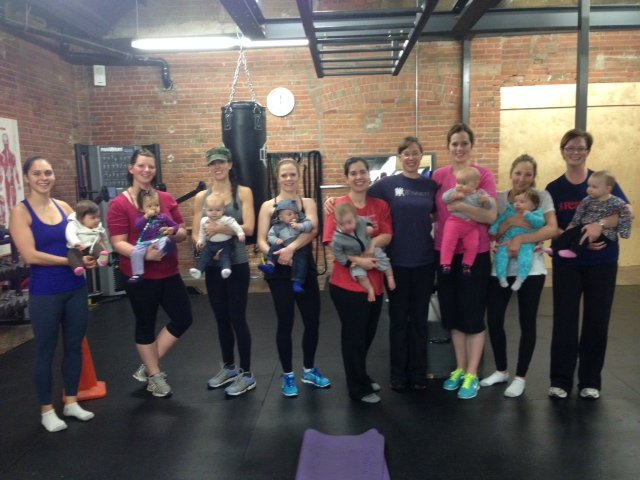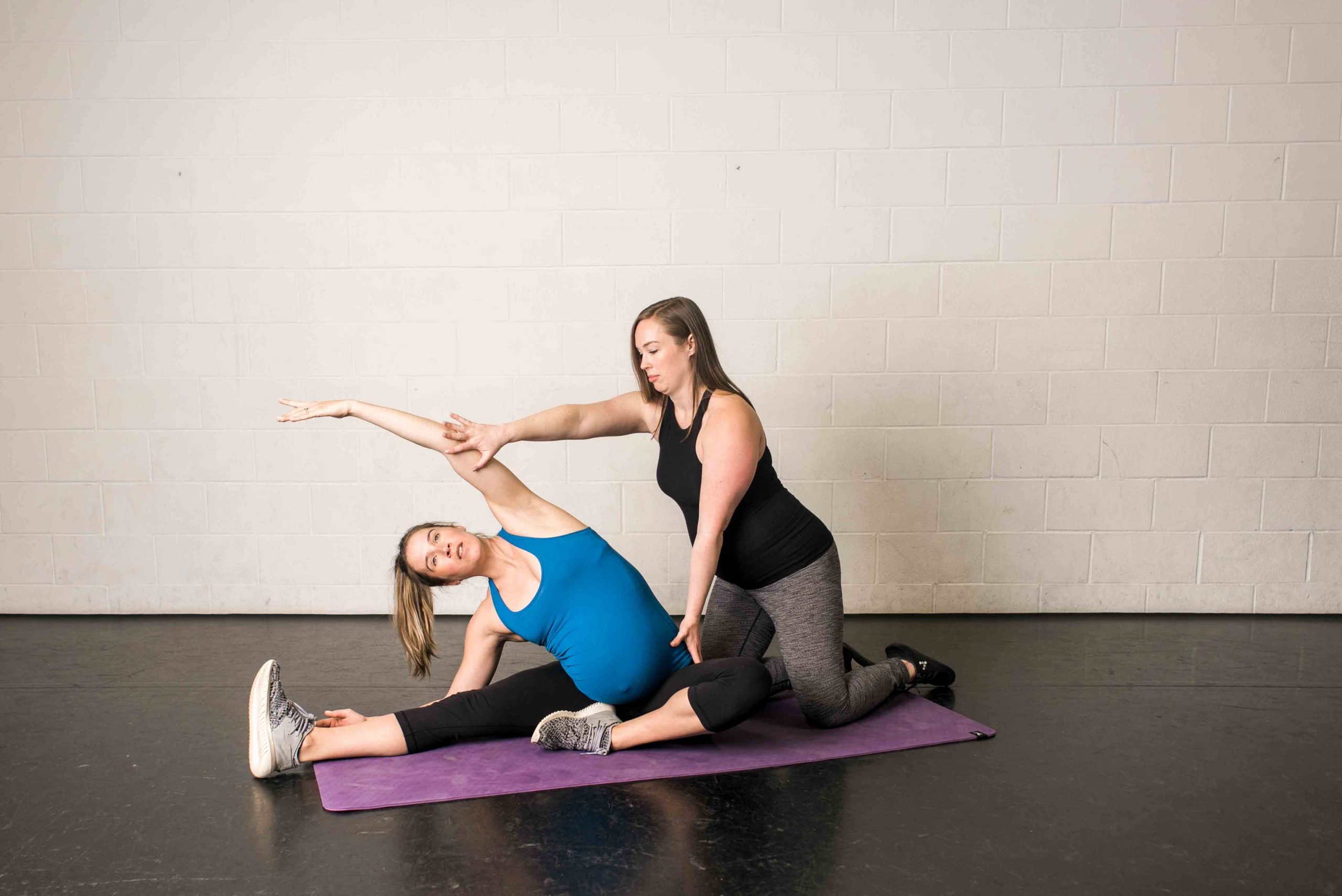Mums of the world! These are the 8 things you MUST know about exercising post-babe. Hint: no where here will this include crunches, running, or the ‘next big thing’ to lose the baby weight the fastest.
My good friend Shira, from Mom Beyond Baby, asked to interview me on the most common questions she receives from her ladies on exercising after baby. This was originally posted over on Shira’s site and I highly recommend checking out all the incredible ways she’s helping mums! We’re in this together 😉 Shira works with a ton of moms in her Healthy Mom Lifestylers Club – which is just for moms who are looking for a more balanced approach to life…fitness, nutrition, and motherhood.
A mom herself, Shira has been through the postpartum return to exercise and is really honest about her leaking pelvic floor when she tried to run at 4-weeks post. She felt the pressure to “get her pre-baby body back”, which can be a heavy burden for any woman, and especially so as a fitness professional.
Personally, I’m SO done with the ‘pre-baby’ garbage. Let’s get the focus on how the body feels and functions. This is what Shira and I chatted about and the details on how to successfully return to exercise.
1). Shira: Tell us a little about you and your passion for pre and postnatal women.
Jessie: Thanks for having me to your “house”, Shira! My name is Jessie Mundell and I live in Calgary, Alberta, Canada. I’m originally from Ontario, but education and career moves have taken my husband and I to the other side of the country.
I work with women in the fitness, health, and wellness realm. I am a personal trainer and nutrition coach, and I specialize in working with pre/postnatal women.
The main bulk of what I do is teaching women how to exercise safely through pregnancy and recover well postpartum. I like to take the focus off what the body physically looks like or looked like, and truly celebrate our ability as women to grow a baby and nurture it.
I like to re-direct our attention to how the body functions and how we feel in our body. How can we best minimize the aches and pains of pregnancy? Is the pelvic floor working? Do you know the best positions to labour in? Are you confident in your postpartum rehab exercises? This is truly the important stuff and the stuff I focus on.
I love working with these women because it’s a time of major change and I hope to bring some calming vibes to it. Additionally, pre/postnatal care is generally lacking and I try to offer sound education that women can trust.
2). Shira: We spend 9-10 months being pregnant, gaining weight and growing a human and naturally the first thing we think about is getting back in shape. Always focused on getting our body back. The doctors recommend 6 weeks until we are “cleared.” I know I started moving way before. What is your thought on the whole “6 weeks”?
Jessie: Yes, the “holy grail” 6-week check-up ![]() Important, yet not all it’s cracked up to be, to be honest. We’ve assumed that 6-weeks is a reasonable amount of healing time and while I appreciate the check-in, it is misleading for many women. Women think they are cleared for all exercise because that is often what their doctor tells them. They’re not. At the 6-week mark, there’s plenty of safe exercises that can be done and plenty of very dangerous exercises that can be done.
Important, yet not all it’s cracked up to be, to be honest. We’ve assumed that 6-weeks is a reasonable amount of healing time and while I appreciate the check-in, it is misleading for many women. Women think they are cleared for all exercise because that is often what their doctor tells them. They’re not. At the 6-week mark, there’s plenty of safe exercises that can be done and plenty of very dangerous exercises that can be done.
There’s also a misconception that no exercising should be done until that 6-week check-up. In most cases, starting to heal the core and pelvic floor should begin almost immediately post-birth. Depending on how labour and delivery play out, gentle movement can be extremely beneficial in the early days and weeks postpartum. Examples being: walking, breathing exercises, glute bridges, clamshells, bodyweight squats, and resistance band rows.
Time and time again, women get this 6-week clearance, are told they’re ready to exercise, and get back into damaging activities such as running, jumping, crunches, sit-ups, etc. All of which, will do more harm than good, regardless of your fitness level.
The body composition changes (fat loss, etc) will come. It’s just going to take time. There’s so many factors at play, including lack of sleep, hormonal changes, little time for activity, increased stress. Just control what you can control. Eat nourishing food, move your body in ways that feel good, sleep when you can, take time to breathe and relax.
3). Shira: What can and should we do after baby? What are some safe exercises for a new mom?
Jessie: You should start by paying close attention to your alignment, as much as possible. This sounds simple, but it’s a workout in itself, especially when carrying a baby. Tough! I tend to see women standing, sitting, or exercising in positions that don’t allow their core muscles (think abdominals, pelvic floor, spinal muscles) to work properly. We end up with a poochy tummy, flat bum, and a leaking pelvic floor.
To get into good alignment, you want your ribcage stacked over your hips. Make sure you have a nice arch through your lower back, your bum is not tucked under (like you’re a sad dog), and you’re growing tall through the crown of the head. Don’t skip out on this step as it sets the foundation for everything you’ll do from here on out.
Next, retrain your breathing to get the core functioning as a unit. This is called core breathing or diaphragmatic breathing. Basically, you’ll want to retrain your core muscles to work together through your inhale and exhale breaths in order for your body to have the ability to be strong and stable. This will not only make your tummy flatter, but reduce those annoying “mom injuries” like back pain when lifting your babe out of the crib or carrying the car seat.
I ALWAYS recommend seeing a pelvic floor physical therapist postpartum. Best to go within the first 6-weeks, but honestly, if it’s been 20 years find a trained therapist and go. It’s the best education in your pelvic floor you’ll ever get. They can do an internal exam and truly tell what is happening with those muscles and organs.
4). Shira: Is there a difference in recovery for women who had vaginal deliveries and C-sections?
Jessie: The process is the same, although the rate at which we progress will be a tad slower because we’re dealing with major surgery. That’s really important to take note of, C-section is major surgery! It’s not a minor procedure.
C-sections require a good deal of healing time and focused rehab. It’s really not a “wait 6-weeks and you’ll be fine to exercise” thing. We need to master the alignment, make sure the scar (layers and layers deep) is healing well, do mobilization to that scar tissue, etc. Again, you don’t have to and should not wait 6-weeks to move, but be cautious when re-starting exercise.
This article will be really helpful if you’ve had a C-section delivery.
5). Shira: There is a lot of talk about the Diastasis Recti. Can you explain what that is and how to fully recover if you do in fact have it?
Jessie: Yes! Diastasis Recti Abdominis (DRA) is a very common occurrence in pregnancy and postpartum (most current data says about 2/3 of women). This is when the rectus abdominis muscles, the “6-pack muscles”, separate to the sides down the midline of your belly. There’s a left and right half to these muscles, held together by connective tissue (the linea alba) from your sternum to your pubic bone. This connective tissue can get lax and become less taut.
The mid-line of your belly might feel soft and squishy, especially near your belly button, and you might see a “doming” of your stomach muscles when you sit up from lying down. You could just feel like your belly looks 4 months pregnant or bloated all the time. Sound familiar?
The good news? You already know where to start: alignment and the breath. You’ll want to practice exercises where you’re in “ribs over hips” positions, and avoid exercises like crunches, sit-ups, and high impact exercises. Exercises such as squats, lunges, rows, and side planks can be great options.
6). Shira: Many moms are overwhelmed with a new baby and don’t start working out until months later. Would they still need to heal their core and work on recovering before doing any intense exercise?
Jessie: Absolutely. You start healing from whenever you get back into the swing of things. I always say that postnatal is forever. Regardless of if you’re 2 weeks postpartum, or 20 years postpartum, the process follows the same steps.
Shira: What are your thoughts on working out during pregnancy? Have you seen a faster recovery in the women you work with from those who maintained fitness throughout their pregnancy?
Jessie: I love women to be active during pregnancy. I definitely see better birth outcomes and faster recovery times in women who have maintained an exercise routine, especially a strength training routine.
In pregnancy, you are training for labour. Everything my ladies do during pregnancy in their workouts is to prepare them for labour, delivery, and caring for an infant. Babies get heavy ![]()
Make sure the intensity levels are managed in pregnancy, especially towards the later stages. There is no competition for who can squat the heaviest or who can run the furthest at 37 weeks pregnant. Your goal is to build or maintain muscle mass, help baby into good pelvic alignment, and develop a core that functions well.
7). Shira: What are some “warning” signs that you are not healed and may need to take a step back? I know I tried to run at 4 weeks and was covered in pee! I cried thinking this was it!
Jessie: Yes! SO common. First of all, the pelvic floor takes 4-6 months to really heal, so please no running in those early months and until you’ve rehabbed.
You could be experiencing:
- Low or mid back pain.
- Pelvic pain, in the front or back or pelvis.
- Overactive bladder – feeling like you have to pee all. the. time.
- Not being able to empty the bladder or rectum fully.
- Pain during intercourse.
- Incontinence – leaking urine, feces or uncontrollable gas.
- Prolapse – the uterus, bladder, and/or rectum beginning to droop down (eventually unmanaged can come out of the vagina or anus – see you PF physical therapist!).
- Feelings of heaviness in the pelvis.
8). Shira: Lots of talk about doing kegels and pelvic floor exercises during pregnancy. Is there any correlation to doing them or not doing them as far as recovery goes?
Jessie: There is research that says pelvic floor exercises DO improve the health of the pelvic floor.
Here’s the trick – you must do your exercises consistently and properly! Too often, we get so good at the contraction of the pelvic floor and the relaxation of the pelvic floor is lacking. We need the muscles to be able to fully relax and contract, to move through a full range of motion. Or, we’re not actually engaging the pelvic floor muscles quite right.
Kegels are often not connected to the breath, they’re just done as a static hold, which makes them less useful. Stick to the breathing exercise for now and really focus in to relax the floor and then gently contract the floor. Try for 2 sets of 10 breaths daily – that’s it! Quality over quantity in everything you do.
Shira: Thanks for taking the time to answer some of these questions. If my mama’s want to contact you for further questions or coaching, where can they find you?
Primarily, you can find me at jessiemundell.com. I blog weekly and you can contact me directly if you have any questions. I also contribute regularly to Girls Gone Strong.
I coach clients from a distance 1-on-1, so I’m incredibly lucky to work with ladies from all over the world. I also coach a group program called The Postnatal Body Project, re-opening this Monday August 18th.
*FYI: The Postnatal Body Project is focused on healing the core and pelvic floor, building a solid foundation of body strength, and really starting to embrace the body for all it is capable of. Click here to register or to ask me any questions you may have.
Thanks, Shira! 🙂
JMG





